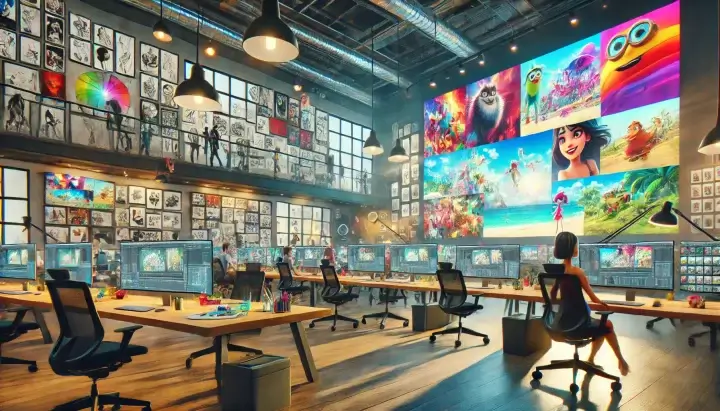Introduction
In today’s global film market, movie localization plays a vital role in ensuring films resonate with international audiences. Whether you are a content buyer looking to acquire localized films or a filmmaker aiming to reach audiences across different regions, understanding how to navigate the localization process is critical. Localization not only involves translating language but also adapting cultural references to ensure films connect with local audiences. This article will explore the importance of movie localization, how the process works, best practices, and how Vitrina Business Network (VBN) can help connect you with leading localization services to prepare your films for international success.
Key Takeaways
| For Sellers | For Buyers |
| Learn how to localize movies effectively for different regions. | Discover how movie localization can boost international audience reach. |
| Understand the challenges of localization and how to overcome them. | Use Vitrina to find localization service providers for accurate subtitling and dubbing. |
| Discover tools and techniques for adapting films to multiple languages. | Ensure your content meets the cultural and linguistic needs of international markets. |
Table of content
- Introduction to Movie Localization
- Movie Localization vs. Other Methods
- Best Practices and Challenges in Movie Localization
- Movie Localization for Specific Content Types
- Impact of Movie Localization on Distribution and Audience Reach
- Tools, Technology, and Costs in Movie Localization
- How to Localize Movies for Various Regions and Platforms
- Legal and Regulatory Considerations
- Conclusion and Case Studies
- FAQs
Looking for Affordable Localization Services?

Introduction to Movie Localization
What is movie localization?
Movie localization is the process of adapting a film for international audiences by translating language, dubbing, subtitling, and altering cultural references. Localization ensures that the film resonates with the local culture and audience preferences. This process goes beyond simple translation by incorporating aspects like humor, idioms, and visual references.
How does movie localization work?
The localization process involves several key steps, including:
- Translation of the original dialogue into the target language.
- Cultural adaptation to make the film relatable to local audiences.
- Voiceovers and dubbing to match the original actors’ lip movements.
- Subtitling for audiences who prefer the original language with translated text.
Why is movie localization important?
Localization is essential for expanding the reach of your film globally. It allows films to break through language and cultural barriers, helping them succeed in diverse markets. For instance, localized films tend to perform better in non-English-speaking regions, boosting both box office returns and streaming platform performance.
Movie Localization vs. Other Methods
Movie localization vs. dubbing
While dubbing is part of the localization process, it is not the entire picture. Dubbing focuses solely on replacing the original dialogue with translated voiceovers, while localization adapts the whole film, including visuals, text, and cultural elements, for the target audience.
- Dubbing: Replaces audio without altering the cultural context.
- Localization: Adapts both audio and visuals, making films more relatable to the local audience.
Movie localization for subtitles and dubbing
Subtitles and dubbing are two major components of movie localization. Both methods are used to make films accessible to international audiences, but they serve different preferences. Subtitles allow viewers to hear the original language while reading translated text, whereas dubbing replaces the original voice with local voice actors.
- Subtitles: Keep the original audio intact but add text for translation.
- Dubbing: Replaces the original audio entirely with a local language track.
Is Your Film Ready for International Markets?

Best Practices and Challenges in Movie Localization
Best practices for movie localization
To ensure effective movie localization, follow these best practices:
- Work with native language experts who are familiar with both the source and target cultures.
- Ensure accuracy in translation, while maintaining the film’s tone and emotional impact.
- Test localized versions to ensure they resonate with the audience without losing meaning.
- Adapt visual elements, such as signage or text on-screen, to match the language and cultural norms.
Movie localization challenges and solutions
Localization is not without its difficulties. Some common challenges include:
- Cultural misunderstandings: Certain jokes, references, or idioms may not translate well.
Solution: Use cultural consultants to guide adaptation decisions. - Technical difficulties: Synchronizing voiceovers with mouth movements can be complex.
Solution: Use advanced localization tools that offer precise lip-syncing capabilities.
Movie Localization for Specific Content Types
How to localize animated films
Animated films pose unique localization challenges because the voiceovers need to match animated lip movements. Additionally, some cultural references in animated films may not translate well visually. Localization for animation involves working closely with the animation team to ensure seamless synchronization.
Movie localization for indie films
For independent filmmakers, localization can be a cost-effective way to expand a film’s audience. Vitrina helps indie filmmakers find affordable localization services that cater to smaller budgets while ensuring high-quality output.
- Indie filmmakers can access localization services to boost international distribution.
Movie localization for multilingual audiences
Films that are targeted at multilingual or diverse audiences benefit from offering both dubbing and subtitling options. By making your film accessible in multiple languages, you can increase audience engagement and reach, particularly in multicultural regions.
Impact of Movie Localization on Distribution and Audience Reach
Benefits of movie localization for global distribution
Movie localization allows films to enter new markets and increase international revenue. A well-localized film is more likely to perform well on global streaming platforms and at international box offices.
- Increased accessibility for non-English-speaking audiences leads to higher viewership.
- Expands distribution opportunities to regions like Asia, Latin America, and Europe.
How movie localization impacts global box office
Films that undergo effective localization often perform better in international markets, leading to increased box office revenue. For example, movies like “Parasite” and “Coco” became global sensations due to successful localization efforts that resonated with different cultures.
How movie localization boosts viewer engagement
Viewers are more likely to engage with a film when it reflects their language and cultural identity. Localized movies create a more immersive experience, resulting in higher audience retention and better reviews.
Need to Reach Multilingual Audiences?

Tools, Technology, and Costs in Movie Localization
Movie localization costs
Localization costs depend on factors like the film’s length, the number of languages required, and the complexity of cultural adaptations. It’s important to allocate budget for localization early in the post-production process to ensure that the film is prepared for international release.
Movie localization tools and software
Several localization tools make the process faster and more efficient:
| Tool | Purpose |
| AI-based translation tools | Automates subtitle translation and helps with quick localization. |
| Linguistic analysis software | Ensures translations maintain the film’s tone and context. |
| Lip-syncing technology | Helps synchronize dubbed audio with on-screen visuals. |
Trends in movie localization
Advances in AI and machine learning are revolutionizing the field of movie localization. These technologies are helping to reduce localization timelines and improve accuracy, ensuring that the final product maintains its integrity across different languages and cultures.
How to Localize Movies for Various Regions and Platforms
Movie localization for global streaming platforms
Streaming platforms like Netflix and Amazon Prime require highly localized content to appeal to their international viewers. Localizing movies for streaming services involves adapting everything from the dialogue to the metadata.
How to localize movies for different regions
Each region comes with its own set of cultural nuances and preferences. Successful localization requires a deep understanding of the cultural, legal, and regulatory standards of the region. Vitrina helps connect filmmakers with local experts to ensure the film meets regional expectations.
Movie localization for platforms like Netflix
Netflix has set the standard for localized content by offering dubbed and subtitled versions in dozens of languages. Partnering with professional localization companies ensures that the film maintains its original intent while catering to local audiences.
Legal and Regulatory Considerations
Legal considerations for movie localization
When localizing films, it is essential to comply with local regulations and censorship laws. Different regions may have specific guidelines about what can and cannot be shown, and failure to comply can result in penalties.
Movie localization and copyright challenges
Localization sometimes requires adjusting copyrighted materials, such as music or visuals. Filmmakers need to secure appropriate copyright permissions before making any changes to ensure that their film remains legally compliant in each market.
Conclusion
As the demand for international content grows, movie localization is becoming increasingly essential. Vitrina helps streamline the localization process by connecting filmmakers and buyers with trusted localization experts, ensuring your film is ready for a global audience. Ready to expand your film’s reach? Start exploring Vitrina today!
Frequently Asked Questions
Vitrina connects filmmakers with leading localization experts who specialize in dubbing, subtitling, and adapting films for diverse markets.
Yes, Vitrina offers access to localization professionals experienced in working with major streaming platforms, ensuring your film meets global standards.
Vitrina provides access to affordable localization services, helping indie filmmakers reach new markets without excessive costs.
Yes, Vitrina offers localization services in multiple languages, allowing filmmakers to distribute their films in a wide range of regions.
Buyers can use Vitrina to source films that have been professionally localized and are ready for distribution in international markets.






























